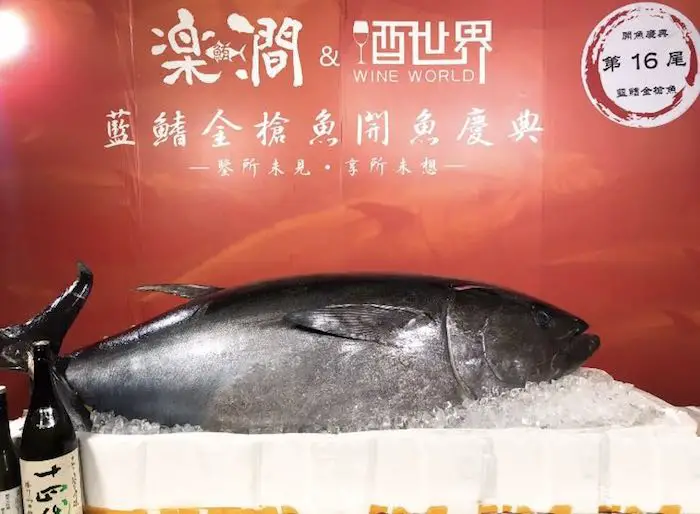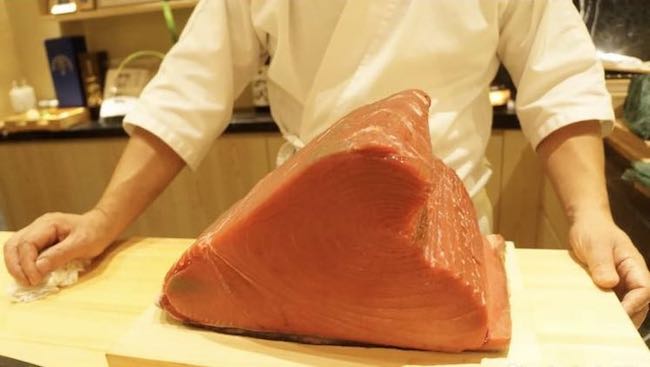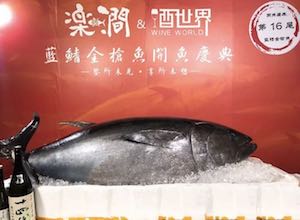We are reader supported. When you purchase through links on our site, we may earn an affiliate commission. Also, as an Amazon affiliate, we earn from qualifying purchases.

Ah! Tuna. The perfectly sliced red colored fillet glistens like a precious gem when served as sashimi or used as a topping on nigirizushi. It looks and tastes incredible, no wonder the spicy tuna sushi is one of the most popular Japanese delicacies. But, do you know that all tuna pieces are not alike.
Tuna flesh is graded depending on the section from which it is derived and they vary widely in terms of flavor, taste, and price. The spicy tuna sushi that you get in the supermarket or grocery store may be cheap, but if you order an exclusive toro sushi in a restaurant, it would cost several dollars more.
Does that make you wonder why there’s such a huge gap in terms of taste and price of fillets derived from the same species of fish? If you are a huge tuna fan or are beginning to develop a liking for tuna, here’s some information that will enrich your knowledge and help you order more wisely the next time you are in a sushi restaurant.
Contents
Toro vs Maguro vs Akami
All these three types of red meat come from the same species of fish known as Bluefin Tuna or Maguro (pronounced as mah-goo-roh). However, they are graded into different categories based on the level of fatty deposits and the ratio between fat and red meat.
Although today maguro is regarded as one of the most sought after fish used in making sushi, it wasn’t as popular a few decades ago. I will tell you more about how and what changed the fortune of this fish later in the article.
What Is Toro

Toro is known as the most prized meat section derived from the underbelly area of the fish. It is heavily embedded with fatty deposits that give a creamy and buttery texture to the meat. Due to the visible fatty deposits in between red meat, it often sports a marbled appearance. The toro pieces are further broken down into two different subtypes – Chutoro and Otoro.
Chutoro (pronounced as choo-toh-roh) is the medium fatty meat derived from the belly portion of the tuna fish. It is taken from the area that lies between the akami region and otoro region. Many sushi lovers prefer Chutoro for making nigiri or rolls because it is not as fatty as otoro yet sports a soft and buttery texture which makes it superior to akami.
Otoro (pronounced as oh-toh-roh) is an extremely fatty area of the Bluefin Tuna. This type of fatty meat is carefully derived from the underside of the belly. The rich flavor and creamy texture come from the fact that it contains the highest deposits of fatty tissues. The otoro pieces are so buttery that it almost melts inside the mouth and feels like it can fall apart any moment when you lift it.
Why is otoro so expensive
Otoro is the most exclusive cut of the tuna fish that is less in quantity compared to the entire fish but has a heavy demand. In the high-end restaurants, these pieces may be served as a prized delicacy. The scarcity of toro has earned it a lot of fame and a heavy price tag.
Currently, about 80% of the bluefin tuna population in the world is used for making sushi. As a result, the species is close to becoming threatened. Due to this, tuna can be ridiculously expensive. A Japanese friend once told me that he has seen people waiting on the docks for hours to buy the freshest and most prized catch of the tuna fishermen.
However, you may not be so lucky as those who live closer to the sea. If you wish to make toro sushi at home (see recipe), you will need to tell your fishmonger in advanced because it is not easily available. When you are lucky enough to buy toro fillets, follow this recipe (link to the article ‘how to make toro sushi) to make a delicious treat for your family.
What Is Akami
Akami (pronounced as ah-kah-me) is the more commonly found and leaner meat derived from the side portions of a tuna fish. If you visit any random sushi restaurant and order a tuna roll from the menu, they will give you this cut of the fish, unless you specially request for toro.
Thus, akami refers to that part of tuna fish that has less fat and higher content of meat. Although it’s simple in terms of flavor and taste, some sushi connoisseurs often tend to prefer this variety over otoro. Other than sushi, akami is often consumed as zuke wherein the cut slices of fish are pickled in soy sauce.
Akami is a such a popular variety of tuna fish that some shops often refer these leaner slices of meat as maguro. If you looking for interesting ways to make tuna sushi at home, read this article (link to the tuna sushi article).
5 Things You Must Know About Akami
Akami meat comes from around the spine region of bluefin tuna fish. It is highly sought after by those following a low-carb or low-fat diet.
The akami slices are crimson in color and look fascinating to the eye. The meat has a nice aroma similar to the sea and sports a sweet flavor with a salty taste for extra sharpness.
Akami perfectly complements the sushi rice and other ingredients to form an extremely popular and delicious sushi roll.
Akami tuna fillets are cheap and you will not break the bank even if the buy the best quality. It is available at a reasonable price in Japan and around the world.
Akami slices from bluefin tuna may often be confused with Ahi tuna species that are found in Hawaii. When buying akami, pay attention to the color because akami is crimson while slices from slight pink have a pinkish hue.
What Is Maguro (Tuna Fish)
In the history of nigirizushi, tuna holds a special place and it has been used widely to make delicious Japanese delicacy. In the past, the non-fatty sections of tuna were more in demand but now the fatty parts have gained immense popularity among the sushi enthusiasts.
Generally, there are about six types of tuna fish used in making sushi
• Honmaguro or
• Taiseiyou maguro (northern bluefin tuna)
• Minami maguro or indo maguro (southern bluefin tuna)
• Mebachi maguro (bigeye tuna)
• Binchou maguro (albacore tuna)
• Kihada maguro (yellowfin tuna)
In Japan, minami maguro and kuro maguro are typically considered as the high-class tuna. The type of tuna used in sushi may also differ depending upon the sushi restaurant and the availability of sushi-grade fish.
The meat of the bincho maguro (albacore tuna) is a pale pink and this species is typically used in several conveyor belt sushi restaurants. Another popular variety of tuna used for sushi making is known as the bluefin tuna and this is what you will usually find in the high-end restaurants.
You can have a look this video for more info:
When Did Maguro Became So Popular?
The immense popularity of tuna in sushi may make you feel like this the pinnacle of fine sushi and has always been like that. However, this is not true. The fate of tuna fish was not always so bright. It has come a long way from being considered as an unclean or cheap fish that the high aristocrats in Japan would not eat to a highly-prized item.
Surprisingly, just a few decades ago, tuna fish was only consumed by the impoverished manual laborers and often used as cat food. Today, tuna sushi is a highly prized item and otoro slices are to die for. In fact, tuna was so disliked in the 1920s that self-respecting Japanese called it genzakaka, which is the Japanese term for inferior fish.
According to the sushi experts, tuna sushi became popular when the early Japanese sushi chefs started using this readily available and reasonably priced fish for making nigiri. Yohei Hanaya, one of the pioneers of sushi started using tuna to make hand-pressed sushi as the fish was abundant.
Hanaya had his sushi shop in a busy cross-section of the street where he used the fresh catch of the day blended with a bed of vinegared rice. This quick and delicious snack became extremely popular as hungry passersby stopped at the shop to get their fill. Most people believe that the cradle of spicy tuna roll was in the Edo period.
When the sushi culture reached the shores of the western countries, Tuna was one of the reasonably priced fish that the Japanese chefs could get fresh. Tuna or maguro, known as the red meat fish instantly became a popular delicacy in LA/West Coast for its meaty texture and no-fishy flavor.
| Toro | Maguro | Akami | |
| What it means in English | Japanese term for tuna meat derived from the under belly area | Japanese term for | Leaner and cheaper meat derived from the side areas of the fish |
| Sub -categories | They are of two types – Otoro and Chutoro | It comes in 6 different varieties and bluefin is typically used for sushi | There are no sub divisions of akami |
| Fat to meat ratio | Embedded with heavy fat, less meat | Depends on the area from which flesh is derived | Less fat and more red meat |
| Taste | Rich sweet taste and buttery texture | Depends on the area from which flesh is derived | Bright flavor, not-so-sweet, more meaty texture |
| Color | Pink to white color | Depends on the area from which flesh is derived | Deep red color with gloss |
Related Questions
Can I eat toro sushi in pregnancy?
While many doctors say there’s no harm in eating raw fish during pregnancy, I would recommend that you avoid eating takeaway sushi from grocery stores. Eat sushi only at reputed sushi restaurants or make them at home using sushi-grade items. Toro is best avoided when you are carrying a baby to prevent any health risks.
What veggies taste best with tuna sushi roll?
When making a tuna sushi roll at home, you can try matching it up with different other veggies to balance the rich texture of toro or chutoro. Some options are cucumber, avocado, red pepper, green onions.
Where can you find bluefin tuna?
Bluefin tuna is abundantly available in the various world oceans such as the Pacific and Atlantic. The bigeye and yellowfin tuna are mainly found in the tropics, while the albacore tuna are found in the temperate waters.


